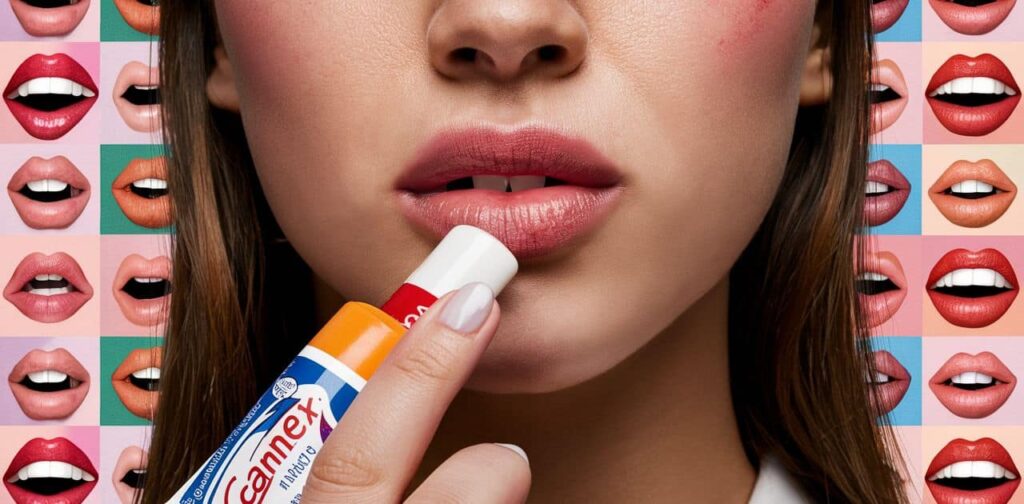The beloved Carmex lip balm has been a household staple for decades, offering a soothing respite for chapped and dry lips. However, recent concerns have sparked curiosity about the safety of its ingredients. Are the components in Carmex truly detrimental to your lip health, or is it a reliable lip care solution? In this comprehensive review, we’ll delve into the scientific evidence, examine expert dermatologists’ insights, and explore real user experiences to unravel the truth about Carmex’s ingredients and their potential impacts.
Almost A Century Of Carmex
Founded in 1937 by Alfred Woelbing, Carmex emerged as a trailblazer in the lip care industry, marking a transformative chapter in the world of lip care products. Over the decades, the brand has experienced remarkable growth, expanding its influence to all 50 states and becoming a household name.
In the 2000s, Carmex introduced an array of delightful new flavors to its lip balm lineup, including Cherry and Strawberry variants, catering to diverse preferences. A pivotal moment arrived in 2008 when the brand garnered significant attention through an appearance on Oprah’s platform, thrusting Carmex into the limelight and leading to widespread recognition.
For many customers, the beloved Carmex brand serves as a nostalgic reminder of simpler times. The simple act of applying a touch of Carmex on your lips, followed by the signature cooling sensation, evokes fond memories and a sense of comfort.
Recommended Post: Mastering The Art Of The Messy Fringe: A Step – By- Step Guide
Review Of The Ingredients In Carmex Products
To address the concerns surrounding Carmex’s ingredients, we’ll review the three main products sold by the brand: The Original Jar, The Original Tube, and The Original Stick. This comprehensive analysis will shed light on the potentially hazardous components and their associated risks.
1. Classic Lip Balm – Original Jar | Hazardous Ingredients
Petrolatum & Paraffin
Petrolatum and paraffin are commonly found in cosmetics such as lip balms and lipsticks. In these products, they are responsible for structural integrity, adherence to the lips, and overall ease of application due to their softening properties. However, while they are not permitted in food products, their presence in beauty items raises concerns about potential ingestion and accumulation within our bodies.
According to Safe Cosmetics, the primary health risk associated with petrolatum is its potential contamination with PAHs (polycyclic aromatic hydrocarbons), which are considered carcinogenic. PAH exposure has been linked to cancer development, particularly breast cancer.
Salicylic Acid
Salicylic acid is a versatile ingredient found in various products, serving different purposes. In shampoos, it acts as a preservative, combats dandruff, and contributes to overall hair care. However, in facial cleansers, its role shifts to exfoliation and acne management. In facial skincare products, it’s believed to enhance skin texture and alleviate redness and imperfections.
However, salicylic acid has recently garnered attention for potential concerns. Research conducted by Danish experts has provided compelling scientific evidence suggesting that salicylic acid can disrupt the endocrine system. This disruption appears to have effects on reducing testosterone levels and influencing sperm production, raising concerns about its long-term impact on reproductive health.
2. Classic Lip Balm – Original Tube | Hazardous Ingredients
Petrolatum & Paraffin
Similar to the Original Jar, the Original Tube contains petrolatum and paraffin, which are responsible for the product’s structural integrity, adherence to the lips, and overall ease of application due to their softening properties.
While they are not permitted in food products, their presence in beauty items raises concerns about potential ingestion and accumulation within our bodies.
According to Safe Cosmetics, the primary health risk associated with petrolatum is its potential contamination with PAHs, which are considered carcinogenic. PAH exposure is linked to cancer development, particularly breast cancer.
Salicylic Acid
Like the Original Jar, the Original Tube also contains salicylic acid, a versatile ingredient found in various products. While beneficial for certain purposes, such as combating dandruff in shampoos or exfoliating in facial cleansers, salicylic acid has recently garnered attention for potential concerns.
Research conducted by Danish experts has provided compelling scientific evidence suggesting that salicylic acid can disrupt the endocrine system. This disruption appears to have effects on reducing testosterone levels and influencing sperm production, raising concerns about its long-term impact on reproductive health.
3. Classic Lip Balm – Original Stick | Hazardous Ingredients
Ethylhexyl Methoxycinnamate Or Octinoxate
Octinoxate is an UV filter found in the Original Stick formulation. According to Safe Cosmetics, octinoxate can spur cell growth due to its estrogen-mimicking properties, a known breast cancer risk factor. It also affects thyroid hormones, which are vital for metabolism and gland development. In females, it disrupts hormone levels, possibly causing infertility, while in males, it lowers sperm count.
Concerns about octinoxate extend to reproductive organs and development. Its antiandrogenic effects can alter organ development in fetuses, potentially affecting offspring. Additionally, octinoxate has been shown to change organ weight and structure in rats, further highlighting its potential impact on overall health.
Benzophenone-3
Benzophenone-3 is another UV filter found in the Original Stick formulation. Responsible for a significant number of allergies (more than a quarter of subjects reacted in an experiment measuring its allergenic power), this ingredient is nearly excluded from sunscreens due to its potential risks.
It’s classified as an endocrine disruptor, and in 2011, the French Agency for the Safety of Health Products advised limiting its use in cosmetic products.
According to Safe Cosmetics, “Benzophenone is persistent, bioaccumulative and toxic (PBT). These chemicals are linked to cancer, endocrine disruption, and organ system toxicity.”
Petrolatum & Paraffin & Ozokerite
Like the other Carmex products, the Original Stick contains petrolatum and paraffin, which are commonly found in cosmetics such as lip balms and lipsticks. In these products, they are responsible for structural integrity, adherence to the lips, and overall ease of application due to their softening properties.
While they are not permitted in food products, their presence in beauty items raises concerns about potential ingestion and accumulation within our bodies.
According to Safe Cosmetics, the primary health risk associated with petrolatum is its potential contamination with PAHs, which are considered carcinogenic. PAH exposure is linked to cancer development, particularly breast cancer.
The Original Stick also contains ozokerite, a mineral wax that serves a similar purpose to petrolatum and paraffin in providing structure and adherence to the product.
Salicylic Acid
Consistent with the other Carmex products, the Original Stick also contains salicylic acid, a versatile ingredient found in various products. While beneficial for certain purposes, such as combating dandruff in shampoos or exfoliating in facial cleansers, salicylic acid has recently garnered attention for potential concerns.
Research conducted by Danish experts has provided compelling scientific evidence suggesting that salicylic acid can disrupt the endocrine system. This disruption appears to have effects on reducing testosterone levels and influencing sperm production, raising concerns about its long-term impact on reproductive health.
Users Reviews & Side Effects
While the ingredient analysis provides valuable insights, it’s essential to consider real user experiences and feedback to gain a comprehensive understanding of Carmex’s effects.
Effects Of Carmex Products – Short Term
Carmex Lip Balm receives positive reviews worldwide for its effectiveness and quality, with users praising its ability to provide immediate relief for dry, cracked lips. The product’s minty flavor and scent are appealing to many, and it offers various flavors, including Cherry and Strawberry, catering to diverse preferences.
Many users appreciate the tingling, cooling sensation upon application, which can be attributed to the menthol ingredient. However, some users have reported that Carmex can cause a burning sensation on their lips, especially with prolonged use or if their lips.
Why Does Carmex Burn My Lips?
While many users enjoy the tingling sensation Carmex provides, some have reported experiencing a burning sensation on their lips after application. This burning sensation can be attributed to several factors:
- Sensitivity to Ingredients: Some individuals may have a sensitivity or allergic reaction to specific ingredients in Carmex, such as menthol, camphor, or phenol. These ingredients can cause irritation and a burning sensation, especially if the lips are already chapped or cracked.
- Exfoliation Effect: Carmex contains salicylic acid, which is an exfoliating agent. While it helps remove dead skin cells, it can also cause a stinging or burning sensation on already compromised lips. This effect is often temporary and may subside as the lips heal.
- Overuse or Excessive Application: Applying too much Carmex or using it excessively can exacerbate the burning sensation. The concentration of irritating ingredients may become too high, leading to discomfort and potential damage to the delicate lip skin.
User Review: “I’ve been using Carmex for years, and while I love the immediate relief it provides, I’ve noticed that if I apply too much or use it frequently when my lips are already cracked, it can cause a burning sensation that’s quite uncomfortable. I’ve learned to use it sparingly and avoid applying it to open wounds or severely chapped areas.” – Emily, 28
It’s important to note that individual experiences can vary, and some users may be more sensitive to certain ingredients than others. If the burning sensation persists or becomes severe, it’s advisable to discontinue use and consult a dermatologist or healthcare professional.
Effects Of Carmex Products – Long Term
While Carmex provides immediate relief and a soothing sensation upon application, some experts caution about potential drawbacks with long-term use.
Does Carmex dry out your lips?
This product seems to offer immediate relief, thanks to its menthol flavor that provides a cooling sensation upon application. Users often experience a tingling effect, which can be attributed to the menthol ingredient. However, while it offers a quick soothing sensation, there’s a potential drawback when used over an extended period.
“It’s a relentless cycle of trying to keep pace,” remarks Dr. Gary Slaughter, a dermatologist practicing in Charlotte, North Carolina. The initial application might seem effective, but it’s not long before the layer you’ve applied begins to dry out and can even be rubbed off, leading to a cycle of reapplication and potential long-term dryness.
Dermatologists pinpoint “camphor, phenol, and menthol” as the troublesome elements in balms that can exacerbate dryness, leading to persistent lip cracks. While salicylic acid is included to exfoliate dry skin, it might ironically leave some individuals with drier and peeling lips, compounding the issue.
User Review: “I’ve been using Carmex for years, and while it provides temporary relief, I’ve noticed that my lips tend to become drier and more chapped over time. It’s like a vicious cycle – I apply Carmex to soothe my dry lips, but then a few hours later, they feel even drier, and I have to reapply. I’m considering switching to a more natural, nourishing lip balm.” – Sarah, 31
Some users have reported that with consistent use over time, the product seems to have a tendency to cause lip dryness and even minor irritation. This experience is not universal, as many customers continue to use Carmex without issues, but it’s important to be aware of the potential long-term effects.
Is Carmex Addictive?
A common concern raised by some users is the potential for Carmex to be addictive. While there is no scientific evidence to support this claim, the perception of addiction may stem from the temporary relief and tingling sensation provided by the product.
When the lips start to feel dry again after the initial application, users may feel compelled to reapply Carmex to experience that same soothing sensation. This cycle of reapplication can create a habit or perceived dependency, leading some to believe that Carmex is addictive.
However, it’s essential to understand that this perceived addiction is likely due to the temporary nature of the product’s effects and the natural drying cycle of the lips, rather than any addictive properties in the formulation itself.
User Review: “I’ve heard people say that Carmex is addictive, and while I can understand why they might feel that way, I don’t think it’s an actual addiction. It’s more like a habit – you get used to the tingling sensation and the temporary relief, so you keep reapplying. But if you switch to a different lip balm or moisturizer, the perceived ‘addiction’ goes away.” – Alex, 35
It’s important to approach this concern with an objective mindset and recognize that while Carmex may create a habit or routine, it is not scientifically classified as an addictive substance. Moderation and awareness of potential long-term effects are key when using any lip care product.
Carmex Closeup
Carmex is a popular lip balm that has been around for decades, and its effects on lips can vary widely from person to person. Many customers have used Carmex without experiencing any issues and have found it effective in moisturizing and soothing their lips. These positive experiences often lead to a strong sense of loyalty and love for the product. However, other customers have experienced dryness, chapped lips, and potential irritation, highlighting the importance of considering individual sensitivities and reactions.
While Carmex’s effectiveness and immediate relief are undeniable for many users, it’s crucial to remember that the product’s success should not overshadow concerns about its ingredients. Certain components found in Carmex lip care products, like petrolatum, paraffin, salicylic acid, octinoxate, and benzophenone-3, are being scrutinized for their potential harm to human health. Studies suggest these chemicals may have negative effects on our bodies, including potential cancer risks, endocrine disruption, reproductive issues, and organ system toxicity.
Conclusion
In conclusion, Carmex works well for many customers, providing temporary relief and a nostalgic experience. However, the presence of concerning ingredients raises questions about the long-term safety and potential side effects of regular use. Opting for safer, natural alternatives without these controversial components may be a more prudent choice for those seeking a risk-free lip care solution. If you have a genuine fondness for the Carmex brand, considering the Carmex Naturally lip balm, which is free from harmful chemicals, could be a viable option.
Ultimately, it’s essential to weigh the benefits against the potential risks and make an informed decision based on your individual circumstances and preferences. Consulting with a dermatologist or healthcare professional can provide personalized guidance on the most suitable lip care products for your unique needs.







